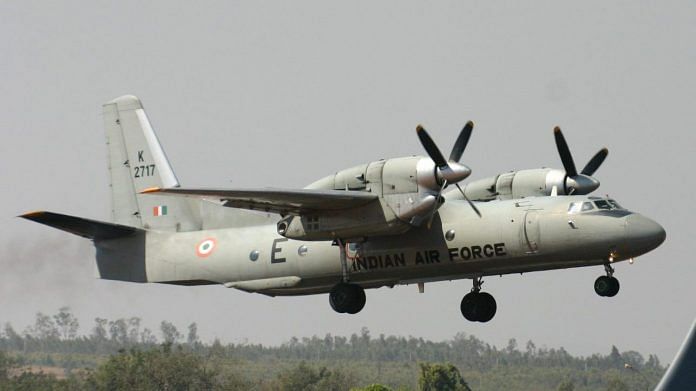New Delhi: An Indian Air Force military transport aircraft Antonov AN-32, with 13 personnel on board, went missing Monday while heading to Mechuka in West Siang district of Arunachal Pradesh, near the border with China. Despite a massive search operation launched to locate the missing aircraft that continued all night, it is yet to be traced.
The IAF had deployed Sukhoi Su-30 combat fighter jets, a C-130 Hercules special operations aircraft and Mi-17 choppers, while the Indian Army deployed Advanced Light Helicopters (ALH). The district administration of Shi Yomi district in Arunachal Pradesh also launched a search operation, with the cooperation of local villagers.
Wing Commander Ratnakar Singh, the Shillong-based spokesperson for the Indian Air Force, said search operations resumed Tuesday, with two Mi-17s and one ALH deployed with ground parties of the Army and the Indo-Tibetan Border Police.
ThePrint traces the origins of AN-32, its role in India’s air security, and its safety record.
Also read: 10 years ago, another IAF AN-32 crashed in the same location with same number of people
Role of the AN-32
The Antonov AN-32 is a military transport aircraft, an upgraded version of the AN-26, which was purchased by India from the erstwhile Soviet Union in 1984. It is a twin-engine turboprop aircraft, and had been employed as a tactical transport aircraft by the IAF since the beginning.
The AN-32 is considered one of the most reliable transport aircraft in the IAF inventory. It can carry a maximum weight of 27 tons at a maximum speed of 530 km/h. Its ability to carry up to 6.7 tons of cargo or 50 passengers has made it the preferred option across a wide variety of terrain.
“The primary task for these AN-32 Squadrons of the IAF is to deliver all that is needed for the sustenance of soldiers entrenched ‘far from the maddening crowd’ [sic] in the service of the nation,” retired Wing Commander Abhishek Matiman wrote for News18.
Its strength includes covering tactical ranges (small to medium ranges), unlike other heavy lift military transport aircraft such as C-17, and being able to operate from remote airfields which may have makeshift arrangements and minimum ground infrastructure.
The aircraft can also play a crucial role during conflict, particularly in the mobilisation of troops and material. It also has a limited bombing role, and is used for paratrooping operations.
For instance, during the Kargil conflict in 1999 and the subsequent Operation Parakram in 2001-02, the aircraft played a major role in transporting men and material to the border areas through frequent flights.
Modernisation got delayed
After a 2009 crash of an AN-32, India had signed a US $400 million contract with the Ukrainian manufacturer Antonov to upgrade the IAF’s 105 AN-32s by overhauling the airframes and Ivchenko AI-20 turboprop engines, and fitting the platforms with advanced avionics, navigation and communication equipment.
The upgradation programme got stalled in 2015 due to the conflict between Ukraine and Russia when the latter annexed the Crimea region, but India and Ukraine agreed to resume the upgrade programme as Kiev has developed alternatives to replace the Russian-made systems on the platforms.
The upgrade will take three to four years to complete. It will be carried out at the IAF’s base repair depot (BRD) in Kanpur, using equipment transferred from Ukraine.
While around 55 aircraft have been modernised, highly-placed sources in the security establishment told ThePrint that the aircraft that went missing Monday was not one of those upgraded.
“Given the treacherous terrain as well as adverse weather conditions that exist in most of the area of operations for the Jorhat-based transport fleet, the upgraded aircraft, which are yet to be deployed, could increase their survivability,” a source said.
Also read: IAF workhorse AN-32 gets a fuel that’s green and creates jobs for tribals
Accident-prone
The AN-32 has been accident-prone since its induction in 1984 — this is the ninth incident involving the aircraft, according to The Economic Times.
Other reports quoting Aviation Safety Network records list 77 occurrences in its accident list for AN-32 globally, of which 15 were IAF aircraft.
The lists include a crash on 10 June 2009, when an IAF AN-32 crashed at around the same place in Arunachal Pradesh killing all 13 people on board, and an AN-32 travelling from Chennai to Port Blair that went missing on 22 July 2016 with 29 people on board.




9 accidents in 36 years with a fleet that big operated extensively in a challenging climate, on makeshift runways, and maintained often in sub-standard way – and you call it accident prone?! Shameless!